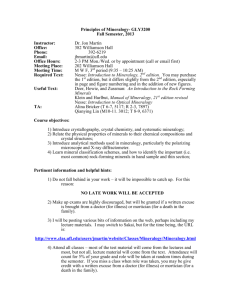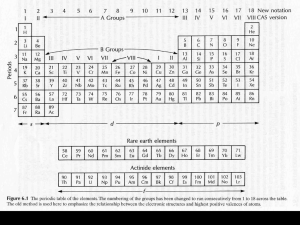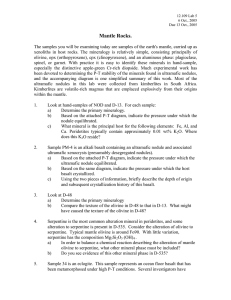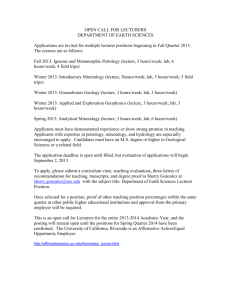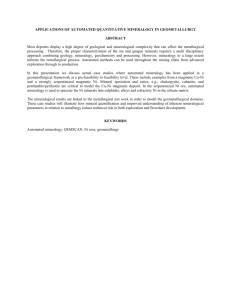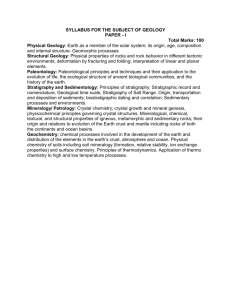core-mantle boundary assignment
advertisement
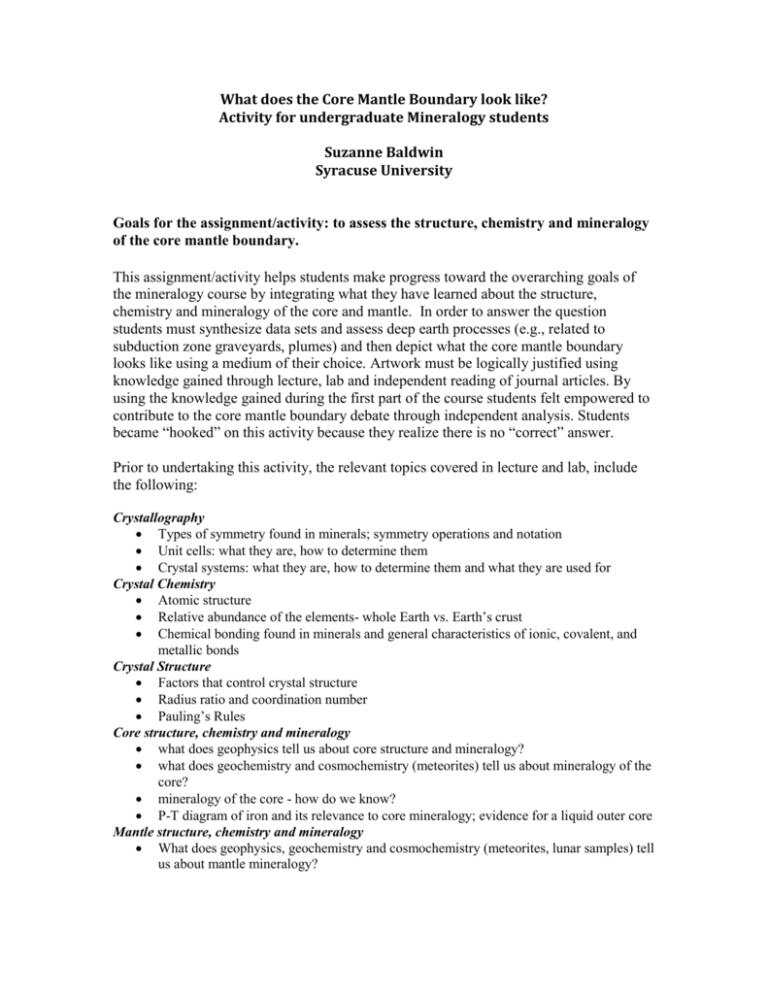
What does the Core Mantle Boundary look like? Activity for undergraduate Mineralogy students Suzanne Baldwin Syracuse University Goals for the assignment/activity: to assess the structure, chemistry and mineralogy of the core mantle boundary. This assignment/activity helps students make progress toward the overarching goals of the mineralogy course by integrating what they have learned about the structure, chemistry and mineralogy of the core and mantle. In order to answer the question students must synthesize data sets and assess deep earth processes (e.g., related to subduction zone graveyards, plumes) and then depict what the core mantle boundary looks like using a medium of their choice. Artwork must be logically justified using knowledge gained through lecture, lab and independent reading of journal articles. By using the knowledge gained during the first part of the course students felt empowered to contribute to the core mantle boundary debate through independent analysis. Students became “hooked” on this activity because they realize there is no “correct” answer. Prior to undertaking this activity, the relevant topics covered in lecture and lab, include the following: Crystallography Types of symmetry found in minerals; symmetry operations and notation Unit cells: what they are, how to determine them Crystal systems: what they are, how to determine them and what they are used for Crystal Chemistry Atomic structure Relative abundance of the elements- whole Earth vs. Earth’s crust Chemical bonding found in minerals and general characteristics of ionic, covalent, and metallic bonds Crystal Structure Factors that control crystal structure Radius ratio and coordination number Pauling’s Rules Core structure, chemistry and mineralogy what does geophysics tell us about core structure and mineralogy? what does geochemistry and cosmochemistry (meteorites) tell us about mineralogy of the core? mineralogy of the core - how do we know? P-T diagram of iron and its relevance to core mineralogy; evidence for a liquid outer core Mantle structure, chemistry and mineralogy What does geophysics, geochemistry and cosmochemistry (meteorites, lunar samples) tell us about mantle mineralogy? seismic velocity discontinuities and their relationship to changes in mineral structure and compositions mineralogy of the lower mantle, transition zone and upper mantle typically discussed includes majorite, ringwoodite, magnesiowustite, perovskite, stishovite, olivine, pyroxene, garnet, periclase P-T diagram of SiO2 and its relevance to mantle mineralogy Examples of readings from the literature: Garnero, E. J., McNamara, A.K., 2008, Structure and Dynamics of Earth’s Lower Mantle, v320, Science, 626-628. Kamada, S., Terasaki, H., Ohtani, E., Sakai, T., Kikegawa, T., Ohishi, Y., Hirao, N., Sata, N., Kondo, T., 2010, Phase relationships of the Fe–FeS system in conditions up to the Earth's outer core, Earth and Planetary Science Letters 294, 94–100. Lassak, T.M., McNamara, A.K., Garnero, E.J., Zhong, S., 2010, Core–mantle boundary topography as a possible constraint on lower mantle chemistry and dynamics, Earth and Planetary Science Letters 289, 232–241. Exam 1 Take Home Question What does the core-mantle boundary look like? There is no unique “correct” answer to this question. You may use any medium to illustrate your answer but the work must be your own and you must justify why the coremantle boundary looks the way you have depicted it. Be sure to properly reference any sources you have used. I have posted several papers on blackboard that we have referenced during our discussions in class, but do not limit your selves to these papers. Have fun! Steps to take: 1) Research this topic- use your notes, handouts, papers posted on blackboard, websites, etc. Engage your mind! 2) Decide -in your own mind- what the core-mantle boundary looks like. 3) Choose a medium (i.e., a type of art used to communicate your ideas) 4) Depict the core-mantle boundary using your chosen medium 5) Finally justify your work in your own words. Be sure to check your spelling and grammar before you hand in your work. All references used must be cited, including websites. Use the papers on blackboard as a guideline for citing references. DUE: This take home exercise is due in class on insert date/time of Exam I. At that time you will take the rest of the exam that will consist of questions (multiple choice, short answer, essay) and mineral identification. Examples of answers provided by Fall 2010 EAR314 students, Dept of Earth Sciences , Syracuse University Acknowledgements: With thanks to Lauren Briggs, Ryan Campbell, Melanie Germeroth, Darcy Joyce, Sarah Obermeier, Lauren Ottaviano, Zachary Rivers, Rachel Valletta
